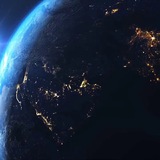This media is not supported in your browser
VIEW IN TELEGRAM
"Milkdromeda" - this is the name, in all likelihood, will be given to the galaxy formed after the merger of our Milky Way galaxy with the closest to us Andromeda galaxy in 4.5 billion years.
Scientists demonstrated the visual process of the collision of the two galaxies using computer graphics.
Scientists demonstrated the visual process of the collision of the two galaxies using computer graphics.
🔥7❤1🤯1🍌1🆒1
This media is not supported in your browser
VIEW IN TELEGRAM
👨🚀 Astronauts' weekdays on the ISS usually go like this:
- 06:00 - Rise and morning procedures (hygiene, breakfast, health check).
- 07:00 - Morning meeting with Mission Control Centre (discussion of tasks for the day).
- 07:30 - Start of the working day.
- 07:30 - 12:30 - Performance of scientific experiments, maintenance of station systems.
- 12:30 - 13:30 - Lunch break.
- 13:30 - 17:30 - Continued work: experiments, data collection, equipment installation.
- 17:30 - 18:30 - Physical training (on treadmill, exercise bike or weight machines).
- 18:30 - 19:00 - Dinner.
- 19:00 - 21:00 - Personal time (connecting with families, recreation, hobbies).
- 21:00 - 22:00 - Summing up the results of the day, meeting with the Mission Control Centre.
- 22:00 - Preparing for sleep.
- 22:30 - Sleep.
The ISS uses Coordinated Universal Time (UTC) as the standard. This choice allows synchronising the crew's work with ground-based Mission Control Centres located in different countries (e.g. Houston, Moscow).
- 06:00 - Rise and morning procedures (hygiene, breakfast, health check).
- 07:00 - Morning meeting with Mission Control Centre (discussion of tasks for the day).
- 07:30 - Start of the working day.
- 07:30 - 12:30 - Performance of scientific experiments, maintenance of station systems.
- 12:30 - 13:30 - Lunch break.
- 13:30 - 17:30 - Continued work: experiments, data collection, equipment installation.
- 17:30 - 18:30 - Physical training (on treadmill, exercise bike or weight machines).
- 18:30 - 19:00 - Dinner.
- 19:00 - 21:00 - Personal time (connecting with families, recreation, hobbies).
- 21:00 - 22:00 - Summing up the results of the day, meeting with the Mission Control Centre.
- 22:00 - Preparing for sleep.
- 22:30 - Sleep.
The ISS uses Coordinated Universal Time (UTC) as the standard. This choice allows synchronising the crew's work with ground-based Mission Control Centres located in different countries (e.g. Houston, Moscow).
👍7🔥2🥱1
Asteroid 2024 YR4, with a diameter of 70 metres, may collide with Earth on 22 December 2032.
The probability of impact is 6%, with destruction within a radius of 30 kilometres. The remaining 94% assumes a flyby at a distance of 60,000 kilometres.
Observations in 2028/2029 will help to refine the trajectory
The probability of impact is 6%, with destruction within a radius of 30 kilometres. The remaining 94% assumes a flyby at a distance of 60,000 kilometres.
Observations in 2028/2029 will help to refine the trajectory
🤔4👍3🥱3😱1🍌1
Smile back 😃
NASA's Hubble Space Telescope has captured the galaxy cluster SDSS J1038+4849 in the constellation of the Big Dipper.
The image shows a curving line that looks like a smile. It is formed by arcs of light resulting from an effect known as gravitational lensing.
The image also shows two orange "eyes", which are actually very bright galaxies, and a white "nose".
NASA's Hubble Space Telescope has captured the galaxy cluster SDSS J1038+4849 in the constellation of the Big Dipper.
The image shows a curving line that looks like a smile. It is formed by arcs of light resulting from an effect known as gravitational lensing.
The image also shows two orange "eyes", which are actually very bright galaxies, and a white "nose".
👍11❤2💩2🍌1
👽 The Internet is actively discussing a strange square structure on the surface of Mars, about 2 kilometres long - conspiracy theorists have already built many theories.
This is not a photoshop, but a real photo obtained from the Mars Orbiter Camera (MOC). You can verify the authenticity through Arizona State University's Mars Image Explorer.
This is not a photoshop, but a real photo obtained from the Mars Orbiter Camera (MOC). You can verify the authenticity through Arizona State University's Mars Image Explorer.
👍11😨4😱3😁2🍌2🤪2
This photo shows a solar eclipse on Mars ☀️
This image was taken by the Perseverance rover as one of Mars' satellites, Phobos, was passing across the Sun's disc.
Because of its small size, the shadow cast on the planet is of negligible size.
The coloured dots in the background are not stars, but artefacts of the footage.
This image was taken by the Perseverance rover as one of Mars' satellites, Phobos, was passing across the Sun's disc.
Because of its small size, the shadow cast on the planet is of negligible size.
The coloured dots in the background are not stars, but artefacts of the footage.
👍6😱2
🪐 NASA has shared a selection of the highest quality photos of the planets in the solar system.
❤12🔥3👍2🤩1
